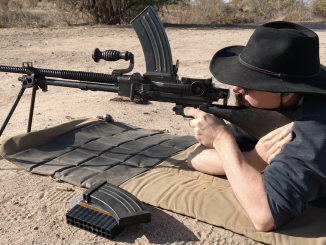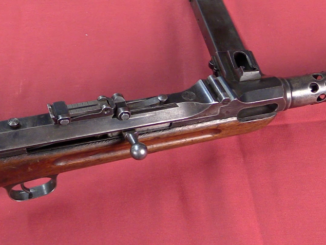Thanks to the hospitality of the National WWII Museum in New Orleans, we had a chance to examine and disassemble a Japanese Type 11 light machine gun. This is, of course, the very unusual hopper-fed design from Kijiro Nambu, which entered service in 1922. The action is largely derived from Hotchkiss guns, but the feed mechanism is unique to the Nambu.
For more information, see the larger Type 11 Nambu article in the Vault.




The way the hopper is removed for dis-assembly makes it look like it would be possible to covert it so to use a side mounted magazine (to make it more reliable.)
The design makes perfect sense; the LMG operator could quickly reload from the riflemen, and conversely, the riflemen could quickly reload from the LMG.
Except I seem to recall that the rifle cartridge was a little to powerful for the mg mechanism and so a special reduced charge round had to be issued for the mg. Another beautiful theory murdered by brutal facts!
The separate load for the Type 11 wasn’t an issue of action strength, it was about muzzle flash. The standard 6.5mm load was developed for the Type 38 rifle and had basically no flash from a 31.5 inch barrel. The Type 11 used a far shorter barrel – 17.4 inches – and the standard ammo produced an unacceptable flash. So a new load (using a different powder) was developed to reduce muzzle flash from the short barrel. A side effect was a muzzle velocity about 100fps slower, but that wasn’t the goal and either type of ammo would function in the gun.
I read that at Ian’s post after I made my comment. Nonetheless, the comment stands: A new factory had to be built to make model 11 ammo packed into special boxes and shipped in special quantities to units depending on how many Model 11 they had on strength. So much for the logistical advantage of using rifle ammo and the hopper feed. In fact, when you consider that the IJA also had 2 varieties of 7.7 along with the 2 versions of 6.5…well, i’ve never read of units receiving wrong ammo for their weapons. Perhaps IJA logistical officers were the real samurai!
As far as the interchangeability of the 6.5mm cartridges goes, it’s completely fine. The Type 11 rounds will cause oddly even more velocity loss in the full length barrels of Type 38s, but there will be virtually no muzzle flash and a much quieter report. The 7.7mm rounds are different, though, and that makes considerably less sense.
Tom TB – I strongly suspect you might have overlooked practical ramification of a more recent attempt at making the buddy-supply between LMG/SAW and riflemen work, being the FN Minimi / M249 belt- or magazine-fed in 5.56 MM. That simply does not work, and to me that seems quite obvious why. Being a rifleman in an extended firefight, I’m able to fire 30 aimed shots for effect from each of those last long husbanded magazines, that the Clumsy-Paws with the SAW would just zip through in two pointless bursts if I give them away to him. No-frigging-way! Same with Japs and last strippers. For a combat infantryman there’s simply no such thing as SPARE ammunition – that category exists only behind the front-line. It didn’t work for the Japanese in WW2 (note that 11-Shiki was soon replaced with magazine-fed 96- and 99-Shiki) and it does not work for the M249 SAW.
I was thinking of a worst case scenario, where either the rifleman or the LMG operator were out of the fight.
There’s no carrying handle on it. I wonder how hot the barrel jacket would get?
I’m also rather curious as to when the decision to use different ammunition came about. If the decision came early in the adoption cycle, then why would they persist with the hopper feed? If the decision came later after the Type 11 was in widespread service, then it makes more sense. Perhaps they had a notion of adopting the new round across the board for rifles as well, but that never came to pass for some reason?
I read somewhere that the Soviets liked the idea for the Type 11’s hopper feed and produced a prototype for their DP machine gun. Upon evaluation however, they decided that while the concept was nice the reality of it was something else entirely and dropped the project.
Yep, the Soviets did experiment with the idea: https://www.forgottenweapons.com/light-machine-guns/kubynov-hopper-fed-dp28/
Not sure on the chronology of the ammo.
Note that soviets used the DP (i.e. infantry) machine gun with big diameter flat pan magazine but its derivation – DT (i.e. tank-mounted) machine gun with smaller diameter, but taller magazines which hold 63 round. The DT was also used by paratroopers as it was more portable (has no fixed wooden stock).
Not only that, they have also experimented with ZB-style top-feed box magazines, and and also decided the pannier would stay. These prototypes were mostly study work, not exactly prototypes of the DP, as they were built in 1930s, parallel to the already running production of the DP. They were experimenting with different ways to feed it, but in the end decided to leave it alone. RP-46 belt-fed DP was another of these side-experiments, and the only one that was actually series-produced and introduced into inventory.
MG, there is photographic evidence that an asbestos fore stock was issued to the gunner to aid in carrying the Type 11 around by the barrel. I’ve only seen these in period photos and to my knowledge, none have ever shown up for sale.
Ian,
It looks like the offset stock would actually work better for a lefty since you wouldn’t have to crane your arm around to get to the grip. Seems like the rear bend would impinge on the inside of your wrist when firing right handed, while firing left handed you’d have all the room in the world for your wrist and forearm. Did you get a sense when shoulder the gun? And what’s the history on the dress in the background?
Thomas.
I didn’t notice anything awkward when holding it right=handed, but I wasn’t thinking about the bend in the stock…
As for the dress, I have no idea what it’s significance is (maybe made from a parachute brought home by an Airborne guy?). I was too wrapped up in the Type 11, Sedgley glove gun, and Panzerschreck to pay attention to it. 🙂
This is very cleaver design, deceptively covered under somewhat ‘grotesque’ outer appearance. Both, the bolt and feed and truly amazing. Again, this is proof not to underestimate Japanese ingenuity as is often repeated assertion that “they copied everything” is false.
I bet this gun took lots of Chinese and Allied lives, military and civilian.
Good video – nicely commented!
Glad you liked it! The Japanese may have copied some things (everyone worldwide did), but they had an awful lot of domestic innovation.
Uh, so the stripper clips are laying sideways, and 5 rounds are pulled from the clip on the bottom? And every 5 rounds the gun has to spit the clip out?
If so, that seems to imply that a well coordinated 2 man crew could fire more a kind of semi-continuous burst – a sustained rate of fire of something like 5 rounds every 4 seconds (say) – at least until the gun got too hot.
Is that the gist, or am I more confused than usual?
Now I’m wondering: did Nambu know Perino machine gun which features feeding from box with feed strips?
Yes, they must have been flat on their side, otherwise could not be stripped. My own question would be, what will happen if rounds are laid in randomly to occupy space. That would probably cause high resistance and lockup/ jam.
Although I have been trying to rack my brains to recall the title, the Nambu always reminds me of a book by one of the British adventure writers – Hammond Innes, Alistair Maclean or Desmond Bagley. This was a book about an mercenary being recruited in the UK for a job in North Africa. He prepares his armaments an disguises them on a Land Rover – a hopper fed machine gun, mortar tube as part of the exhaust, spare tyre as the base plate, mortar bombs hidden in fire extinguishers and a detonator with timer behind the odometer. From memory the book talked a good deal about the Nambu as inspiration for the hopper of this disguised MG. Ring any bells for people?
now let’s make a upper for an AR that has a hopper and runs on the 10 round stripper clips
For Victoria Australia: I believe the book was titled (at least in the US) “the Spoilers” and was written by Desmond Bagley. Lord, the things we remember / the things we forget.
Correct!! – and given the internet here it is as a pdf:
http://www.krizma-ebooks.com/books/%20The%20Spoilers.pdf
I’ve always thought this system was pretty cool. Your infantry platoon needs a small arms resupply of 6.5mm stripper clips – that’s all.
I didn’t know about the two different types of 6.5mm ammo until now, but it sounds like that was not a show stopper.
Most other armies of the time would need SMG ammo, rifle ammo, and LMG ammo.